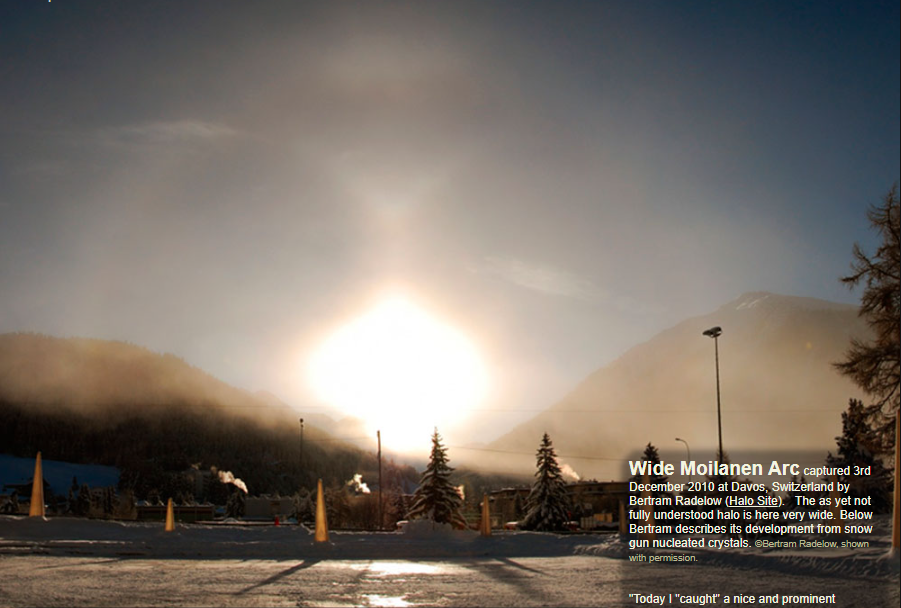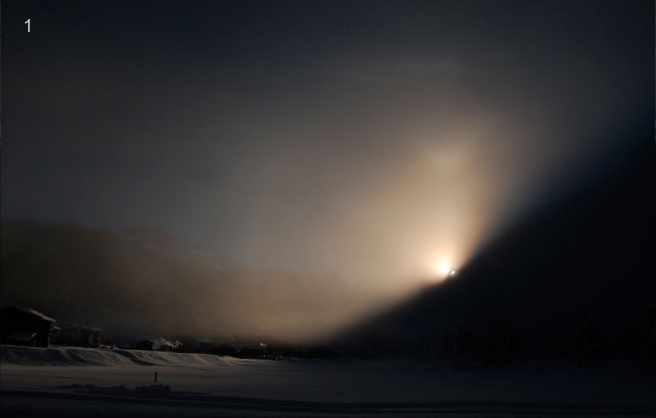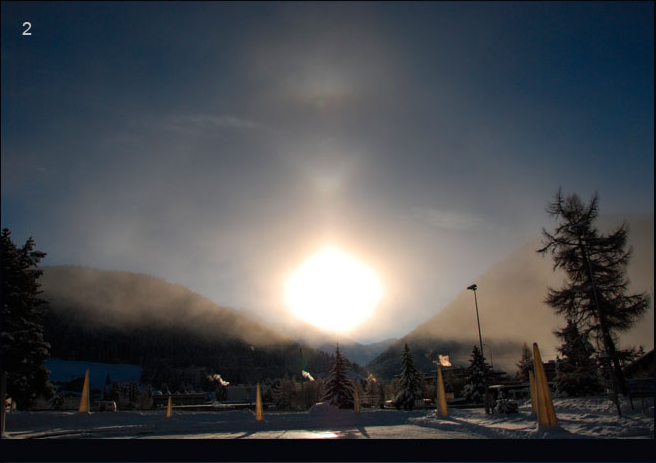OPOD - Rare Moilanen Arc
OPOD - Exploring the Rare Moilanen Arc
Atmospheric optics never fails to amaze us with its intricate and captivating phenomena. One such rare and intriguing optical display is the Moilanen arc. Named after Jarmo Moilanen, a renowned halo expert from Finland, the Moilanen arc forms a distinct 'V' shape above the sun, nestled between the upper rim of the 22° halo and the sun itself.
Unveiling the Origins of the Moilanen Arc
The formation of the Moilanen arc can be attributed to a unique combination of factors. To better understand its creation, let's delve into the details of its development.
-
The Role of Snow Guns: The Moilanen arc owes its existence to the utilization of snow guns, which are devices that eject small seed nuclei into the air. These nuclei serve as a foundation for the subsequent growth of ice crystals through condensation of atmospheric moisture.
-
Crystal Growth: The growth of these ice crystals occurs over vast distances, ranging from hundreds of meters to several kilometers downwind. Interestingly, snow guns that produce exceptional halos employ enzymes as crystal growth nuclei. These artificial crystals possess identical structures, forms, and habits as their naturally occurring counterparts.
-
Optical Perfection: Although the exact reasons remain a mystery, these 'artificial' crystals have been observed to exhibit near-optical perfection and generate rare halos. The Moilanen arc is a prime example of such an extraordinary phenomenon.
Observations and Insights
Now, let's explore some observations and insights into the characteristics and properties of the Moilanen arc:
-
Shape and Positioning: The Moilanen arc appears as a distinct 'V' shape positioned above the sun, between the sun itself and the upper rim of the 22° halo.
-
Coloration: The Moilanen arc exhibits a colored appearance, with a noticeable red lower edge in certain instances. This coloring indicates that the rays forming the arc have undergone refraction.
-
Halo Framing: In some images, a weak and diffuse 22° halo and upper tangent arc surround the Moilanen arc. These diffuse halos suggest that they are produced by very small crystals, aligning with observations that halo-forming crystals were just beginning to form out of the artificial ice fog.
-
Simulating the Moilanen Arc: The shape and positioning of the Moilanen arc can be simulated by tracing rays through an ice prism with two faces inclined at an angle of 34°. The prism edges must be nearly horizontal, with the narrowest part of the 34° wedge at the top.
-
Mysteries of Crystal Formation: The wedge angle of 34° does not correspond to any physically reasonable facets in ice crystals. One possibility is that this specific wedge angle is present in clustered or twinned crystals, adding to the enigmatic nature of the Moilanen arc.
Capturing the Moilanen Arc
Photographers and atmospheric optics enthusiasts have been fortunate enough to capture the rare Moilanen arc on camera. One such instance occurred on December 3rd, 2010, in Davos, Switzerland. Bertram Radelow, a talented photographer, managed to capture the wide Moilanen arc during this event.
Bertram's captivating photographs showcased the development of the Moilanen arc from snow gun nucleated crystals. His images provide valuable insights into the evolution of this rare halo formation over time and distance. From the initial formation of the special Moilanen crystals to their metamorphosis within minutes, Bertram's photographs offer a visual narrative of this mesmerizing atmospheric phenomenon.
In conclusion, the Moilanen arc stands as a testament to the extraordinary wonders of atmospheric optics. Its distinct 'V' shape, colored appearance, and unique positioning above the sun make it a captivating sight for those fortunate enough to witness it. While much remains to be understood about its formation and the precise characteristics of the crystals involved, the Moilanen arc continues to intrigue and inspire both scientists and enthusiasts alike.

Wide Moilanen Arc captured 3rd December 2010 at Davos, Switzerland by Bertram Radelow (Halo Site). The as yet not fully understood halo is here very wide. Below Bertram describes its development from snow gun nucleated crystals. ©Bertram Radelow, shown with permission.

"Today I "caught" a nice and prominent Moilanen arc, produced by snow guns.
At the time I shot the pics the usual icy .radiation. fog which forms during December nights had disappeared completely an hour since. The icy fog in the pictures is a 100% product of an ensemble of six snow guns in downtown Davos. The ice fog then was transported by a very gentle wind and had time to "ripen".
Picture 1 .left. is about 1.3 miles away from the snow gun, time or the drift are 20 minutes, roughly estimated. The pic shows that the special Moilanen crystals are the first to form out of the unstructured grains produced by the gun.


Pictures 2 and 3 are about 1.8 miles away (only five minutes later) and show the further metamorphosis within short time. The "Minuteman rockets" surrounding the small frozen lake are part of a Christmas decoration - illuminated by night in various colors they look pretty nice!"
Snow guns eject small seed nuclei into the air on which halo forming ice crystals subsequently grow from condensation of atmospheric moisture. The growth occurs over hundreds of metres to several kilometres downwind. Snow guns that make the best halos use enzymes as crystal growth nuclei. The 'artificial' crystals have the same structure, forms and habits as naturally occurring ones. However, for reasons not yet understood (type of nucleate, atmospheric conditions), they can be near optically perfect and generate rare halos.
The rare Moilanen arc, named after halo expert Jarmo Moilanen of Finland, is characteristically ‘V’ shaped and appears above the sun between it and upper rim of the 22° halo. In images (2) and (3) a weak and diffuse 22° halo and upper tangent arc frame the Moilanen arc. Diffuse halos can be an indication that they are produced with very small crystals – consistent with Bertram’s comments that halo forming crystals were just starting to form out of the artificial ice fog. The Moilanen arc is however already relatively sharp. Whatever crystals formed it were already of some size and development.
The Moilanen arc is coloured – a red lower edge is visible in the top image – showing that rays forming it have undergone refraction. Its distance from the sun and shape can be simulated by tracing rays through an ice prism with two faces inclined at an angle of 34°. The prism edges must be nearly horizontal with the narrowest part of the 34° wedge uppermost.
The wedge angle does not correspond to that from any facets physically reasonable in ice crystals. One possibility is that the 34° wedge is present in some clustered or twinned crystals.

Note: this article has been automatically converted from the old site and may not appear as intended. You can find the original article here.
Reference Atmospheric Optics
If you use any of the definitions, information, or data presented on Atmospheric Optics, please copy the link or reference below to properly credit us as the reference source. Thank you!
-
<a href="https://atoptics.co.uk/blog/opod-rare-moilanen-arc/">OPOD - Rare Moilanen Arc</a>
-
"OPOD - Rare Moilanen Arc". Atmospheric Optics. Accessed on November 15, 2024. https://atoptics.co.uk/blog/opod-rare-moilanen-arc/.
-
"OPOD - Rare Moilanen Arc". Atmospheric Optics, https://atoptics.co.uk/blog/opod-rare-moilanen-arc/. Accessed 15 November, 2024
-
OPOD - Rare Moilanen Arc. Atmospheric Optics. Retrieved from https://atoptics.co.uk/blog/opod-rare-moilanen-arc/.